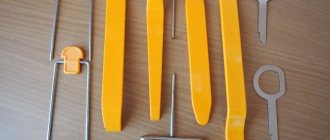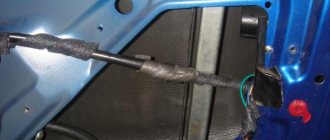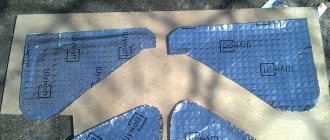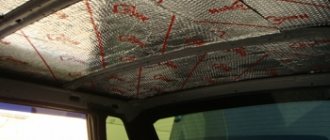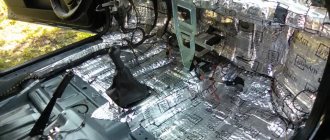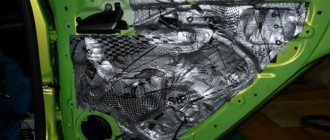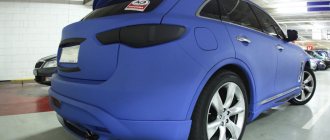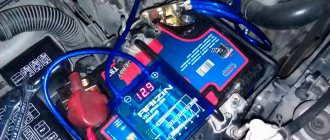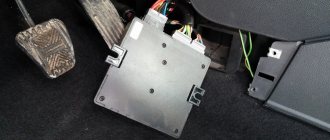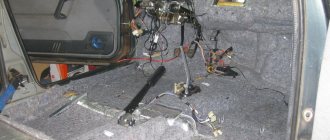Almost every car owner, especially a domestic car, is familiar with the problem of noise entering the cabin through the bottom or arches. Some drivers do not try to deal with this at all, while others, on the contrary, strive to make their car as comfortable as possible.
Until recently, the only solution was the use of noise and vibration insulation, which was special bitumen mats. They need to be glued to the bottom from the interior, disassembling it completely, onto the arches - only from the inside, which, you see, is not very convenient or fast. In addition, laying such material requires heating it.
However, about five years ago, an excellent alternative to them appeared on the markets - liquid car sound insulation. Reviews from car owners show that it is not only more convenient to apply to body parts, but also significantly more effective than regular “Shumka”. What it is, what types of it are on sale and how to use it, we will talk in this article.
What is the essence of liquid sound insulation?
Liquid noise insulation is a special product made on various bases (bitumen, rubber) designed to reduce noise and vibration levels in the car interior. In addition, this product has excellent protective properties that prevent corrosion of body elements. It can be applied to both the internal and external surfaces of the bottom and arches, and can also be used in conjunction with conventional bitumen sound insulation. In this case, the effect of sound and vibration absorption will be the highest.
Why is this necessary?
Most car enthusiasts have never even heard of this method of car soundproofing. Today, sheet sound-proofing and sound-absorbing materials are used “the old fashioned way.”
In principle, they do their job well, but we still can’t talk about high efficiency.
Some road noise still penetrates through the underbody of the vehicle and through uncovered wheel arches. In such a situation, you have to look for more flexible (literally and figuratively) sound insulation options.
External finishing can help in this situation, but standard sheet materials are not suitable for this task.
Their main disadvantage is the fear of moisture. After just a few months of operation, the porous material becomes saturated with water, which significantly reduces its soundproofing properties.
But there is an alternative - liquid sound insulation of the arches, bottom and floor of the car cabin.
Liquid car sound insulation: reviews and benefits
Those car owners who have experienced the effect of liquid “shumka” on their cars unanimously declare its high efficiency. Thrifty drivers see a certain benefit here, namely that there is no need to spend money separately on anti-corrosion treatment, and separately on sound insulation.
In addition, any liquid car sound insulation has a number of advantages over conventional ones. Here are just a few of them:
- high sound-absorbing abilities;
- long service life;
- easy to apply to any surface;
- makes the car heavier by no more than 15 kg, while bitumen increases the weight of the car by 50-60 kg;
- being applied externally, it additionally protects the car body from the harmful effects of gravel, water and road reagents;
- resistant to temperature changes and mechanical stress;
- can be painted to match the color of the car;
- The composition of the product is completely safe for the health of the driver and passengers.
DO NOT MAKE NOISE!
We did not discover America: the cheapest product - an aerosol - had virtually no effect on the noise level. The difference in the “before” and “after” indicators is comparable to the measurement error. Let us note that the Eltrans drugs have no luck at all in this issue (see the material about “anti-rain”), but this is not someone’s malicious intent, but simply an unfortunate coincidence. Thick mastic "AutoNOL" will color the weekend with new shades. It is inconvenient to use a brush under the car, and it is difficult to achieve an even coating if you are not used to it. If you try, the result will be better than after using an aerosol. Although you need to have very sensitive ears to feel the difference.
But the PRIM Anti-Noise material, which is applied with a primer gun, gives an effect - and it can be assessed not only with a sound level meter, but also by ear. So-called evacuated microspheres with rubber crumbs and other clever components significantly reduce the level of noise and vibration in the car interior. At a speed of 90 km/h we managed to gain almost 4 dBA, that is, the car became almost two and a half times quieter! There is only one drawback - it’s a little expensive. And it is difficult to carry out such work on your own - you will have to turn to specialists.
Experienced people, however, say that it is not at all necessary to go to a car dealership. They say that any garage handyman will do such work for less money - guns and lifts are not a novelty today, but the drug can be obtained. Let's not argue with this. In any case, the result is important: you can fight harmful “bacilli”! And in addition to reducing noise levels, you will get a bonus in the form of anti-gravel and anti-corrosion protection for the body, as well as its thermal insulation.
In general, don't make any noise!
Rubber bitumen mastics
Rubber-bitumen mastic is a product consisting of a solution of bitumen and rubber (rubber) with the addition of alkyd resins and plasticizers. The range of these products is quite wide, but none of them are up to the ideal due to the final state of the dried solution. Unfortunately, this liquid car soundproofing does not harden completely, making it more similar to an anti-corrosion coating. The most common rubber-bitumen mastics in our markets are “Kord”, “Kordon”, “BPM-1”, “BPM-97”.
NoiseLIQUIDator
NoiseLIQUIDator is a good Russian-made vibration-absorbing mastic, used mostly for arches, although it is also suitable for the bottom. It consists of two synthetic components: a base and a hardener, mixed in certain proportions immediately before starting work. Can be used to reduce noise on ribbed metal surfaces: bottoms, frames, thresholds, etc. Not recommended for application to plastic.
Apply by hand with a spatula. The hardening time of one layer is a day.
Soundproofing plaster
Soundproofing plaster
Soundproofing can be achieved using soundproofing plaster. It contains special components. These are granules measuring 5 mm. For granules, use pumice or expanded clay. When drying, gas escapes, causing the coating to become porous. Thanks to the loose structure, noise is retained.
Plaster is a 100% safe “eco” material. It is safe for children's rooms. Will not harm those with allergies. A relief plastered wall can decorate the interior.
Applying plaster
Before starting work, you need to prepare the surface: level, clean and apply a primer. It is advisable to add 10% lime paste, then it will grip more firmly.
If you want the wall to be smooth after plastering, you need the soundproofing mastic to have a layer of no more than 2-3 cm. If you plan to finish painting the walls, give preference only to water-dispersion paints.
"Prime Anti-Noise"
Liquid sound insulation "Prime Anti-Noise" is a universal product that simultaneously protects the body from corrosion and reduces the level of noise coming from under the car.
It contains white spirit, modified bitumen, perlite, synthetic resin, crumb rubber, aluminum and zinc powder, as well as corrosion inhibitors. The product is absolutely odorless and completely safe for health. It has high sound insulation, anti-gravel and anti-corrosion properties. Sold as an aerosol in cans. “Anti-noise” can be used to “blow out” hard-to-reach places (hidden cavities of doors, thresholds, side members).
WHAT IS DECIBEL
Decibel (dB) is a dimensionless quantity intended to express on a logarithmic scale the relationship between the measured and the original quantities. Used when measuring values that vary over a wide range: small numbers like 20, 30, or 100 are much easier to handle than ratios of 100, 1000, or 10,000,000,000.
The loudest sound differs from the quietest sound that our ears can detect by 130 dB (10,000,000,000,000 times). The rustling of leaves is approximately 15 dB, an office with employees is about 60 dB, a motorcycle is approximately 85 dB, and the traumatic threshold is about 160 dB.
The sensitivity of the ear depends greatly on the frequency of sound. Therefore, sound level meters introduce the so-called A-correction of the sound pressure level, which brings the measurement results closer to the actual human sensations. This adjusted noise level is also measured in decibels and is designated dBA.
A difference of 3 dBA means that the measured value differs from the base value by half. In the old days, it was fashionable to compare the Chaika with the Muscovites: a cool limousine was quieter than a small car by about 6 dBA!
Liquid sound insulation: price
If you decide to contact a specialized center in order to make your car more resistant to road noise, be prepared to be asked to choose the materials yourself. It’s worth making a reservation right away: you shouldn’t give preference to cheap products, since you’ll need more of them, they won’t last long, and the effect won’t be the same. It is better to choose a product from a well-known brand.
As for the price for soundproofing the bottom and arches, on average it ranges from 4 to 10 thousand rubles. To process only the arches will cost from 1000 to 2000 rubles, depending on the material and the number of layers applied.
How to make liquid sound insulation yourself
Now let's talk about how to apply a product such as liquid noise insulation with your own hands. This is not such a troublesome task. First you need to decide where it will be applied: on internal or external surfaces. Next, based on this, select the appropriate product and calculate its quantity. It is better, of course, to first treat the outside of the car, because inside it will be possible to make additional sound insulation, either with bitumen mats or with the means described above.
Before starting work, the surfaces must be thoroughly washed with hot water, then cleaned of rust and degreased. Only after this can you begin to apply sound insulation using a spatula, brush or sprayer. It’s great if it’s enough for several layers. In this case, apply a second coat only after the first one has completely dried.
Allow the product to dry completely before using the vehicle. This may take 1-2 weeks, but it's worth it.
Preparing for work
Here you need to know the rules, approximately the same as what a painter must know. So, before you start smearing liquid Shumka, do the following:
- We place the car on a lift or slipway or overpass for repairs. If there is no such luxury nearby, then we use a regular jack and sawhorses (so that the car does not hang on the jack).
- Remove the wheels.
- Wash it thoroughly and wait until it dries.
Professionals say that a clean foundation is the trump card. If everything is clean, then the sound insulation will not fly off due to vibration.
Useful tips
When preparing to treat your car with liquid sound insulation yourself, use these tips:
- Do not buy cheap materials from obscure retail outlets. Instead, visit a specialized store, where you will also be advised on the correct use of the product you purchased.
- Pay maximum attention to washing and cleaning the surfaces being treated - only in this case will your work give a good result.
- Before processing, remove the car wheels and insulate the hubs with pads with polyethylene to prevent mastic from getting on them.
- Do not process at temperatures below 10 ° C - the mastic will harden much longer.
- Do not mix different products under any circumstances.
- Do not apply the product in a thick layer. It is better to make several layers, waiting for each of them to dry completely.
- If the processing process seems impossible to you, contact a specialized service center.
